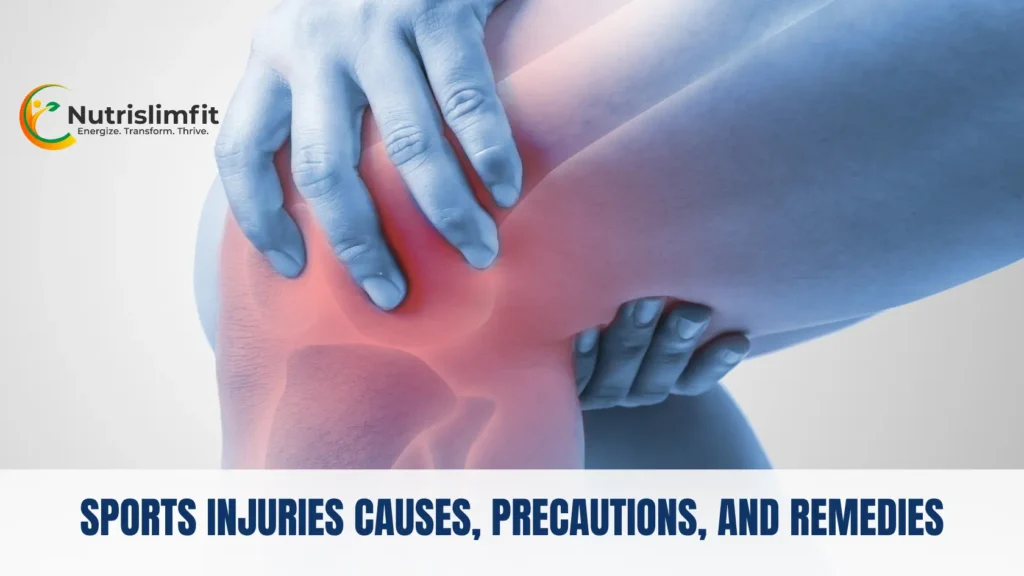
Sports injuries can occur in any physical activity, whether professional or recreational. Understanding the causes, precautions, and remedies for sports injuries is essential for athletes and fitness enthusiasts alike. This comprehensive guide aims to provide insights into the various aspects of sports injuries to help prevent them and manage recovery effectively.
What are Sports Injuries?
Sports injuries refer to physical injuries that occur during physical activity or exercise. These injuries can affect muscles, tendons, ligaments, bones, and cartilage. Sports injuries can be classified into two categories:
1. Acute Sports Injuries
Acute injuries occur suddenly during activity. Common examples include:
- Sprains: Stretching or tearing of ligaments (the tough bands connecting bones).
- Strains: Stretching or tearing of muscles or tendons (the tissues connecting muscles to bones).
- Fractures: Breaks in the bone.
- Contusions: Bruises caused by a direct blow or impact.
- Dislocations: Joints are forced out of their normal position.
2. Chronic Sports Injuries
Chronic injuries develop gradually over time, often due to repetitive stress on a particular body part. Common examples include:
- Tendinitis: Inflammation of a tendon, often due to overuse.
- Bursitis: Inflammation of the bursae (small fluid-filled sacs that cushion bones and tendons).
- Stress fractures: Small cracks in bones caused by repetitive forces or overuse.
Causes of Sports Injuries
Understanding the various causes of sports injuries is crucial for prevention. Some common causes include:
1. Inadequate Warm-Up and Cool-Down
Failing to warm up properly before exercise or cool down afterward can lead to muscle strains and injuries. A proper warm-up increases blood flow to muscles and prepares them for physical activity.
2. Poor Technique
Using incorrect techniques during sports or exercise can increase the risk of injury. Whether it’s improper running form, lifting weights incorrectly, or not following the correct techniques for a sport, poor biomechanics can lead to injuries.
3. Overtraining
Pushing the body beyond its limits without allowing adequate recovery time can lead to chronic injuries. Overtraining can weaken muscles and increase the risk of strains and stress fractures.
4. Inadequate Equipment
Using improper or worn-out sports equipment, such as shoes that don’t provide proper support, can lead to injuries. It’s essential to use equipment designed for the specific sport being played.
5. Playing on Unsafe Surfaces
Uneven, hard, or slippery surfaces can increase the risk of falls, sprains, and fractures. Athletes should be cautious about the playing surface and ensure it is safe for their activity.
6. Lack of Conditioning
Insufficient physical conditioning can lead to injuries, particularly in individuals who suddenly increase their level of activity without adequate preparation.
7. Previous Injuries
A history of injuries can predispose individuals to future injuries. Scar tissue or weakness from previous injuries can make certain areas of the body more vulnerable.
Precautions to Prevent Sports Injuries
Preventing sports injuries requires proactive measures and good practices. Here are some key precautions:
1. Proper Warm-Up and Cool-Down for Sports injuries
- Warm-Up: Incorporate dynamic stretches and light aerobic exercises to gradually increase heart rate and blood flow to muscles.
- Cool-Down: After exercising, cool down with static stretches to help relax muscles and improve flexibility.
2. Use Appropriate Gear for Sports injuries
- Invest in quality, sport-specific equipment. Proper footwear is especially crucial for providing support and cushioning. Ensure that all gear, including helmets, pads, and other protective equipment, is in good condition.
3. Learn Proper Techniques for Sports injuries
- Take lessons or coaching to learn proper techniques for your chosen sport. This can significantly reduce the risk of injury.
4. Listen to Your Body for Sports injuries
- Pay attention to signs of fatigue or discomfort. If you experience pain or unusual fatigue, it’s essential to rest and seek medical advice if necessary.
5. Gradually Increase Activity Levels for Sports injuries
- When starting a new sport or returning after a break, gradually increase intensity and duration to allow the body to adapt.
6. Stay Hydrated for Sports injuries
- Proper hydration is vital for maintaining performance and preventing muscle cramps. Drink water before, during, and after physical activity.
7. Strength and Flexibility Training for Sports injuries
- Incorporate strength training and flexibility exercises into your routine. Strengthening muscles around joints can provide better support and stability, reducing injury risk.
8. Regular Rest and Recovery for Sports injuries
- Allow time for adequate rest and recovery between training sessions to prevent overuse injuries. Incorporate rest days into your training schedule.
Common Sports Injuries and Their Remedies
Here’s a look at some common sports injuries, their symptoms, and effective remedies:
1. Sprains
- Symptoms: Pain, swelling, bruising, and difficulty using the affected joint.
- Remedies:
- Rest: Avoid using the affected joint.
- Ice: Apply ice for 15-20 minutes every hour to reduce swelling.
- Compression: Use an elastic bandage to compress the area.
- Elevation: Keep the affected area elevated above heart level.
- Seek Medical Attention: If severe, consult a healthcare professional.
2. Strains
- Symptoms: Pain, muscle spasms, swelling, and reduced range of motion.
- Remedies:
- Rest: Avoid activities that cause pain.
- Ice: Apply ice to reduce swelling.
- Compression and Elevation: Same as for sprains.
- Gentle Stretching: Once swelling decreases, perform gentle stretches.
- Physical Therapy: In some cases, a therapist may recommend rehabilitation exercises.
3. Tendinitis
- Symptoms: Pain and tenderness along a tendon, stiffness, and swelling.
- Remedies:
- Rest: Avoid activities that worsen the pain.
- Ice: Apply ice to the affected area.
- Anti-Inflammatory Measures: Over-the-counter anti-inflammatory medications may help (consult a healthcare professional before use).
- Gentle Stretching and Strengthening: Work on flexibility and strengthening exercises once symptoms improve.
4. Stress Fractures
- Symptoms: Localized pain that worsens with activity and improves with rest.
- Remedies:
- Rest: Avoid weight-bearing activities.
- Ice: Apply ice to reduce swelling.
- Consult a Professional: A healthcare provider may recommend imaging tests and a treatment plan.
- Gradual Return to Activity: Once healed, gradually return to activities with proper conditioning.
5. Bursitis
- Symptoms: Pain and swelling over a joint, particularly with movement.
- Remedies:
- Rest: Avoid activities that aggravate the condition.
- Ice: Apply ice to the affected area.
- Compression: Use compression to reduce swelling.
- Physical Therapy: A therapist may guide you through exercises to strengthen and improve flexibility in the area.
The Role of Rehabilitation in Recovery
Rehabilitation is a crucial part of the recovery process for sports injuries. A structured rehabilitation program can help individuals regain strength, flexibility, and range of motion. Key components of rehabilitation include:
1. Assessment and Goal Setting
- A healthcare professional or physical therapist will assess the injury and develop a personalized rehabilitation plan, setting specific goals for recovery.
2. Strengthening Exercises
- Once the acute pain subsides, strengthening exercises may be introduced to rebuild muscle strength around the injured area.
3. Flexibility and Range of Motion Exercises
- Stretching exercises can help restore flexibility and improve range of motion in the injured area.
4. Functional Training
- Rehabilitation may include functional training exercises that mimic the movements specific to the sport or activity.
5. Gradual Return to Activity
- The rehabilitation program will gradually reintroduce physical activity to ensure the injury is fully healed and to prevent re-injury.
Psychological Aspects of Sports Injuries
Suffering a sports injury can take a psychological toll on athletes. Feelings of frustration, anxiety, and depression can arise during the recovery process. Here are some strategies to support mental well-being:
1. Stay Positive
- Focus on what you can control and set small, achievable goals during recovery. Celebrate progress, no matter how small.
2. Maintain Connection with Sports
- Stay engaged with your sport, even if you cannot participate. Watching games or supporting teammates can help maintain a sense of belonging.
3. Seek Support
- Talking about your feelings and experiences with friends, family, or a mental health professional can provide emotional relief.
4. Mindfulness and Relaxation Techniques
- Practicing mindfulness, meditation, or relaxation exercises can help reduce anxiety and improve overall mental health during recovery.
Conclusion
Sports injuries can be frustrating and challenging, but understanding their causes, taking preventive measures, and knowing how to manage them can make a significant difference. By prioritizing safety, practicing proper techniques, and allowing adequate recovery time, athletes can reduce their risk of injury and enhance their performance.
If you experience a sports injury, it’s essential to seek appropriate medical advice and follow a structured rehabilitation plan to facilitate recovery. Remember that injuries are a part of sports, but with proper care and precautions, athletes can continue to enjoy their activities while minimizing the risk of injury.
Disclaimer: This article is intended for informational purposes only and does not constitute medical advice. Always consult with a healthcare professional for a proper diagnosis and treatment plan before starting any remedies or rehabilitation programs.
to know about sports nutrition, click here


